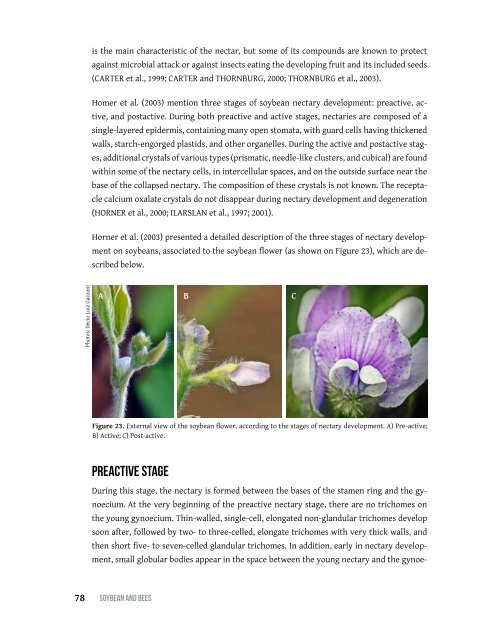Soybean and Bees
Create successful ePaper yourself
Turn your PDF publications into a flip-book with our unique Google optimized e-Paper software.
is the main characteristic of the nectar, but some of its compounds are known to protect<br />
against microbial attack or against insects eating the developing fruit <strong>and</strong> its included seeds<br />
(Carter et al., 1999; Carter <strong>and</strong> Thornburg, 2000; Thornburg et al., 2003).<br />
Homer et al. (2003) mention three stages of soybean nectary development: preactive, active,<br />
<strong>and</strong> postactive. During both preactive <strong>and</strong> active stages, nectaries are composed of a<br />
single-layered epidermis, containing many open stomata, with guard cells having thickened<br />
walls, starch-engorged plastids, <strong>and</strong> other organelles. During the active <strong>and</strong> postactive stages,<br />
additional crystals of various types (prismatic, needle-like clusters, <strong>and</strong> cubical) are found<br />
within some of the nectary cells, in intercellular spaces, <strong>and</strong> on the outside surface near the<br />
base of the collapsed nectary. The composition of these crystals is not known. The receptacle<br />
calcium oxalate crystals do not disappear during nectary development <strong>and</strong> degeneration<br />
(HORNER et al., 2000; ILARSLAN et al., 1997; 2001).<br />
Horner et al. (2003) presented a detailed description of the three stages of nectary development<br />
on soybeans, associated to the soybean flower (as shown on Figure 23), which are described<br />
below.<br />
Photos: Decio Luiz Gazzoni<br />
A B C<br />
Figure 23. External view of the soybean flower, according to the stages of nectary development. A) Pre-active;<br />
B) Active; C) Post-active.<br />
Preactive stage<br />
During this stage, the nectary is formed between the bases of the stamen ring <strong>and</strong> the gynoecium.<br />
At the very beginning of the preactive nectary stage, there are no trichomes on<br />
the young gynoecium. Thin-walled, single-cell, elongated non-gl<strong>and</strong>ular trichomes develop<br />
soon after, followed by two- to three-celled, elongate trichomes with very thick walls, <strong>and</strong><br />
then short five- to seven-celled gl<strong>and</strong>ular trichomes. In addition, early in nectary development,<br />
small globular bodies appear in the space between the young nectary <strong>and</strong> the gynoe-<br />
78 SoybeAn <strong>and</strong> bees


